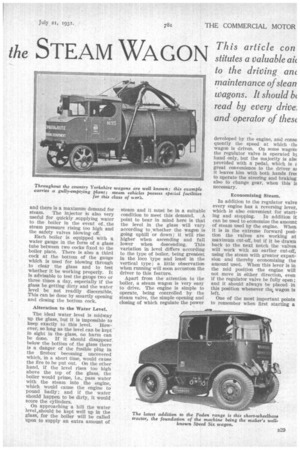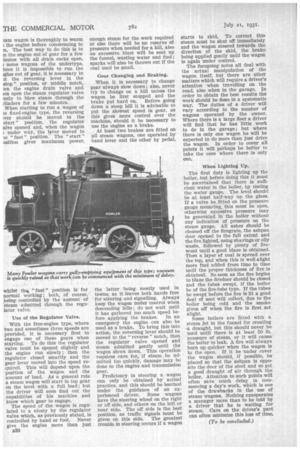the STEAM WAGON
Page 47

Page 48

If you've noticed an error in this article please click here to report it so we can fix it.
and there is a maximum demand for steam. The injector is also very useful for quickly supplying water to the boiler in the event of the steam pressure rising too high and the safety valves blowing off.
Each boiler is equipped with a water gauge in the form of a glass tube between two cocks fixed to the boiler plate. There is also a third cock at the bottom of the gauge which is used for blowing through to clear the glass and to test whether it be working properly. It is advisable to test the gauge two or three times a day, especially if the glass be getting dirty and the water level be not readily discernible. This can be done by smartly opening and closing the bottom cock.
Alteration to the Water Level.
The ideal water level is midway up the glass, but it is impossible to keep exactly to this level. However, so long as the level can be kept in sight in the glass, no harm can be done. If it should disappear below the botttan of the glass there is a danger of the fusible plug in the firebox becoming uncovered which, in a short time, would cause the fire to be put out. On the other hand, if the level rises too high above the top of the glass, the boiler would prime, i.e., pass water with the steam into the engine, which would cause the engine to pound badly ; and if the water should happen to be dirty, it would score the cylinders.
On approaching a hill the water level.,should be kept well up in the glass, for the boiler will be called upon to supply an extra amount of
steam and it must be in a suitable condition to meet this demand. A point to bear in mind here is that the level in the glass will vary according to,whether the wagon is going uphill or down ; it will rise higher when ascending and fall lower when descending. This variation in level differs according to the type of boiler, being greatest in the loco 'type and least in the vertical type ; a little observation when running will soon accustom the driver to this feature.
Apart from the attention to the boiler, a steam wagon is very easy to drive. The engine is simple to operate, being controlled by the steam valve, the simple opening and closing of which regulate the power developed by the engine, and conse quently the speed at which th( wagon is driven. On some wagom the regulator valve is operated b3 hand only, but the majority is alsc provided with a pedal, which is r great convenience to the driver w it leaves him with both hands fret to operate the steering and braking. also to change gear, when this is necessary.
Economizing Steam.
In addition to the regulator valve every engine has a reversing lever, which is also convenient for start
ing and stopping. In addition it can be used to economize the amount of steam used by the engine. When it is in the extreme forward position the valves are working at maximum cut-off, but if it be drawn back to the next notch the valves will work with an earlier cut-off, using the steam with greater expansion and thereby economizing the amount used. When this lever is in the mid position the engine will not move in either direction, even if the regulator valve be fully open ; and it should always be placed in this position whenever the, wagon is left.
One of the most important points to remember when first starting a
aam wagon is thoroughly to warm ) the engine before commencing to m. The best way to do this is to m the engine out of gear for a few Mutes with all drain cocks open.
some wagons of the undertype, here it is impossible to run the tgine out of gear, it is necessary to it the reversing lever in the stop" position, or middle notch, )en the engine drain valve and Len open the steam regulator valve antly to blow steam through the 71inders for a few minutes.
When starting to run a wagon of le fixed engine type, the reversing wer should be moved to the start " position, the regulator alve opened and, when the wagon ; under way, the lever moved to ie"fast" position. The " start" osition gives maximum power, whilst thci, "fast" position is for normal working; both, of course, being controlled by the ameunt of 'steam admitted through the regulator valve.
Use of the Regulator Valve.
With the free-engine type, where two and sometimes three speeds are provided, it is necessary first to engage one of these gears when starting. To do this the regulator valve must be opened slightly and the engine run slowly ; then the regulator closed smartly and the gear lever moved into the speed required. This will depend upon the position of the wagon and the amount of load. As a general rule a steam wagon will start in top gear on the level with a full load ; but the driver will soon find out the capabilities of his machine and know which gear to engage.
The speed of the wagon is regulated to a nicety by the regulator valve which, as previously stated, is controlled by hand or foot. Never give the engine more than just B30 enougn steam for the work required or else there will be no reserve of pressure when needed for a hill, also an excessive blast will be sent up the funnel, wasting water and fuel ; sparks will also be thrown out if the coal used be small.
Gear Changing and Braking.
When it is necessary to change gear always slow down; also, never try to change on a hill unless the wagon be first stopped and the brake put hard on. Before going down a steep hill it is advisable to put the slowest speed in gear, as this gives more control over the machine, should it be necessary to use the engine as a brake.
At least two brakes are fitted on all steam wagons, one operated by hand lever and the other by pedal, the latter beingmostly used in towns, as it leaves both hands free for -steering and signalling. Always keep the wagon under control when descending hills ; do not wait until it has gathered too much speed before applying the brakes. In an emergency the engine can also be used as a brake.. To bring this into action, the reversing lever should be moved to the " reverse " notch, then the regulator valve opened and steam admitted gently until the wagon slows down. This operation requires care for, if steam be admitted too quickly, damage may be done to the engine and transmission gear.
Proficiency in steering a wagon can only be obtained by actual practice, and this should be learned under the guidance of an experienced driver. Some wagons have the steering wheel on the right or off side, and others on the left or near side. The off side is the best position, as traffic signals must be given on this side. The greatest trouble in steering occurs if a wagon
starts to skid. To correct this steam must be shut off immediately and the -wagon steered towards the direction of the skid, the brake being applied gently until the wagon is again under control.
The foregoing notes all deal with the actual manipulation of the wagon itself, but there are other matters which will require a driver's attention when travelling on the road, also when in the garage. In order to obtain the best results the work should be done in a systematic way. The duties of a driver will vary according to the number of wagons operated by the owner. Where there is a large fleet a driver will find that he has little work to do in the garage; but where there is only one wagon he will be expected to do more than just drive the wagon. In order to cover all points it will perhaps be better to take the case where there is only one, When Lighting Up.
The first duty is lighting up the boiler, but before doing this it must be ascertained that there is sufficient water in the boiler, by testing the water gauge. The level should be at least half-way up the glass. If a valve be fitted on the pressure gauge. mounting, this must be open, otherwise excessive pressure may be generated in the boiler without any indication of pressure on the steam gauge. All ashes should be cleaned off the firegrate, the ashpan door opened to the full extent and the fire lighted, using shavings or oily waste, followed by plenty of firewood until a good blaze is obtained. Then a layer of coal is spread over the top, and when this is well alight more fuel added from time to time until the proper thickness of fire is obtained. So soon as the fire begins to blaze the flredoor should be closed and the tubes swept, if the boiler be of the fire-tube type. If the tubes be swept before the fire is lit a good deal of soot will collect, due to the boiler being cold and the smoke given off when the fire is first set alight.
Some boilers are fitted with a steam jet in the funnel for creating -a draught, but this should never be used until there is at least 50 lb. pressure of steam, or it will cause the boiler to leak. A fire will always burn up quicker when the wagon is in the open. If it be under cover the wagon should, if possible, be -placed so that the ashpan is opposite the door of the shed and so get a good draught of air through the boiler. Attention to such points will often save much delay in commencing a day's work, which is one of the drawbacks in the use of steam wagons. Nothing exasperates a manager more than to be told by a driver that he is waiting for steam. Care on the driver's part can often minimize this loss of time.




































































































